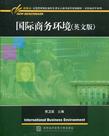国际商务环境
出版时间:1970-1 出版社:对外经济贸易大学出版社 作者:窦卫霖 编 页数:230
前言
随着经济全球化和一体化的深入推进,许多公司把海外扩张作为新时期的发展战略。于是,国际贸易的往来不断增加,贸易环境也不断在改变。加入啪后,我国以史无前例的速度融入经济全球化浪潮。越来越频繁的国际商务活动,对商务人员提出了更高的要求,其中最重要的就是对国际商务环境的深刻了解。因为国际商务活动与国内商务活动的根本区别就在于国际、国内商务环境的不同,各个国家的政策、经济、法规及社会文化习俗的不同。要顺利地进行国际贸易往来,商务人员迫切需要全面了解现行国际经济秩序下的国际商务环境。 本书的立足点在于为从事国际商务活动的人士提供具有实用价值的商务环境指南,其内容涵盖了国际商务活动所面临的最重要的环境因素。全书共分十一章,具体内容安排如下:前三章为概论篇。第一章为背景介绍,概述国际商务活动的基本概念和特点;第二章论述国际商务企业的外部环境;第三章论述其内部环境。第四至第十章为分析篇,分别分析国际商务环境的各个主要方面。第四章介绍国际商务所面临的政治环境,第五章国际商务所面临的经济环境;第六章国际商务所面临的文化环境;第七章国际商务所面临的社会环境;第八章国际商务所面临的法律环境;第九章国际商务所面临的伦理环境;第十章国际商务所面临的技术环境。最后一章为总结篇,阐述国际全球化对国际商务环境的影响,以及环境的变化对国际商务人员的挑战。 本教材希望体现如下特点:一是在内容上力图将国际商务环境理论与实践相结合,以真实生动的国际商务案例说明理论;力图将国际商务环境与中国的国内商务环境相结合,把中国商务活动放到国际商务大环境的背景之下进行分析。二是在教学理念上强调师生的互动,注重提高学习者分析问题、解决问题的能力。每个章节都围绕一个主题精心安排了一系列讨论和辩论问题,并配备了多种形式的练习供师生之间、学生之间讨论交流。三是在编写体例上,力图更便于学习者学习,更能体现国际教材编写的发展趋势,如:考虑到本学科内容覆盖面广的特点,每章节都首先提出学习目标,以帮助学生掌握学习重点。为了帮助学生提纲挈领地掌握各章的内容,文本后面给出了主要内容概括和重点术语及其中文译文;为了帮助自学或自测所学内容,每章练习中有多种形式的练习题;为了拓展读者的阅读范围和视野,每章最后都提供了参考阅读书目和相关网站.还补充了许多与主题有关的小文件夹。
内容概要
《国际商务环境(英文版)》的立足点在于为从事国际商务活动的人士提供具有实用价值的商务环境指南,其内容涵盖了国际商务活动所面临的最重要的环境因素。
作者简介
窦卫霖,对外经济贸易大学英语学院商务英语学系教授,硕士生导师,剑桥大学英语学院和美国佛罗里达州农业工业大学商学院访问学者。 主要研究方向为:语言与文化、跨文化交流、跨文化商务交流、商务英语教学等。 主持国家社会哲学科学研究基金项目和教育部人文社会科学研究项日。 在国内外核心刊物卜公开发表专业论文二十多篇,主编书籍四本,翻译学术专著六部。
书籍目录
Chapter One Background for International Business: An OverviewText: Get Familiar with International BusinessWords and expressionsKey termsNotesSummary of key pointsExercisesCase study: Ford Motor CompanyPoint-counterpoint: Will Warnings about the Safety of Chinese Products Reduce Chinas Dominance in Global Manufacturing and Trade?MinifileWebalertFurther readingChapter Two The External Environment of BusinessText: The Business Organization and Its EnvironmentWords and expressionsKey termsNotesSummary of key pointsExercisesCase study: Disneys Strategy in ChinaPoint-counterpoint: Do Business Environment Reforms Have Great Impact on Poverty Reduction in Africa?MinifileWebalertFurther readingChapter Three The Internal Environment of BusinessText: Organization: the Internal EnvironmentWords and expressionsKey termsNotesSummary of key pointsExercisesCase study: Team-Based Structures at Saab Training SystemsPoint-counterpoint: The Manager: Omnipotent or Symbolic?MinifileWebalertFurther readingChapter Four Political Environment Facing International BusinessText: The Changing Political EnvironmentWords and expressionsKey termsNotesSummary of key pointsExercisesCase study: Should Government Be Running the Railways?Point-counterpoint: Can a Milwaukee Smoking Ban be Enforceable?MinifileWebalertFurther readingChapter Five Economic Environment Facing International BusinessText: The International Economic EnvironmentWords and expressionsKey termsNotesSummary of key pointsExercisesCase study: Chinese Firms Incentives for Foreign AcquisitionsPoint-counterpoint: Helping Developing Nations: Aid or Trade?MinifileWebalertFurther readingChapter Six Cultural Environment Facing International BusinessText: The Challenge of Crossing Cultural BoundariesWords and expressionsKey termsNotesSummary of key pointsExercisesCase study: How Do You Throw Your "Meishi"Point-counterpoint: Does International Business Lead to Cultural Imperialism?MinifileWebalertFurther readingChapter Seven Social Environment Facing International BusinessText: Society and BusinessWords and expressionsKey termsNotesSummary of key pointsExercisesCase study: B&Q in ChinaPoint-counterpoint: Are Clawback Clauses Really a Necessary Evil?MinifileWebalertFurther readingChapter Eight Legal Environment Facing International BusinessText: Legal System in International BusinessWords and expressionsKey termsNotesSummary of key pointsExercisesCase study: Sweatshop EconomiesPoint-counterpoint: Should the America Impose Religion on Secular Law?MinifileWebalertFurther readingChapter Nine Ethical Environment Facing International BusinessText: Business Ethics and Corporate CodesWords and expressionsKey termsNotesSummary of key pointsExercisesCase study: Nestle Infant FormulaPoint-counterpoint: Is It Ever Acceptable to Pay a Bribe in Business?MinifileWebalertFurther readingChapter Ten Technological Environment Facing International BusinessText: Changes in Technological EnvironmentWords and expressionsKey termsNotesSummary of key pointsExercisesCase study: India: A New Tiger Economy?Point-counterpoint: Different Viewpoint on Information Technology ForumMinifileWebalertFurther readingChapter Eleven Global Change and Challenges of the International EnvironmentText: Global Environment of International BusinessWords and expressionsKey termsNotesSummary of key pointsExercisesCase study: Can Market Mechanisms Reduce Global Climate Change? ...Point-counterpoint: Is Regional Planning the Solution, or the Problem? ..-MinifileWebalertFurther reading
章节摘录
Market entry strategies A new foreign market represents both a potential opportunity and a risk to an organization. A companys market entry strategy should aim to balance these two elements. The least risky method of developing a foreign market is to supply that market from a domestic base. This is often not a cost-effective method of serving a market, and may not be possible in the case of some inseparable services where producers and consumer must interact. Where an exporter needs to set up production facilities overseas, risk can be minimized by gradually committing more resources to a market, based on experience to date. Temporary facilities could be established that have low start-up and close-down costs and where the principal physical and human assets can be transferred to another location. Market entry risk reduction strategies also have a time dimension. While there may be long-term benefits arising from being the first company to develop a new product field in a foreign market, there are also risks. If development is hurried and launched before consistent quality can be guaranteed to live up to an organizations international standards, the companys long-term image can be damaged, both in the new foreign market and in its wider world market. In the turbulent business environment of Eastern Europe in the late 1980s, two of the worlds principal fast food retailers —— McDonalds and Burger King —— pursued quite different strategies. The former waited until political, economic, social and technological conditions were capable of allowing it to launch a restaurant that met its global standards. In the case of Burger King, its desire to be first in the market led it to offer a sub-standard service, giving it an image from which it was difficult to recover.
图书封面
评论、评分、阅读与下载
用户评论 (总计0条)
推荐图书
- 选修)溶液
- 劳动技术补充资料 高一/上
- 寒假作业(高中一年级) (平装)
- 选修)牛顿定律的应用 高一二
- 单元练习与阶段测试 高一代数下 (平装)
- 寒假作业(高中一年级)第三版 (平装)
- 选修)美学常识(高一.二) (平装)
- 单元练习与阶段测试 高一代数( 上) (平装)
- 选修)逻辑(高一二用) (平装)
- 模具CAD基础
- 生产服务业发展研究
- 政治经济学
- 区域经济协调发展中的政府作用
- 会计基础
- 会计防错小窍门82招
- 出纳防错小窍门93招
- 企业集团团队合作、持股安排与决策权分配
- 制度经济学研究(第二十四辑)
- 咨询改变人生
- 转变外贸增长方式研究
- 中国经济热点前沿(第6辑)
- 国有商业银行战略转型研究
- 会计模型使用质量的实验比较研究
- 微观经济学
- 科学发展与东北振兴
